|
1.
CENTRAL/ WEST AFRICA
Gabon bans harvest of four major timber species
Very slow market conditions continue in West Africa.
However, significantly, the government of Gabon
indicated that from 1 January 2009, four major species of
timber, afo, douka, moabi, and ozigo, are no longer
permitted to be harvested. Producers will have three
months in which to dispose of all stocks of these species.
The impact of this measure on market prices and the
volume of annual harvest in Gabon has yet to be assessed.
Moabi is a major species for the market in France,
although French importers are currently overstocked with
moabi. Despite this, there may be a rush to secure the
limited stocks that remain in the pipeline. Although
individually the volumes of each of the four species are
not that significant, the ban will mean a noticeable
reduction in the harvest volumes per hectare. This is
expected to impact the viability of some concession areas.
At this stage, there is no information as to whether or not
concession holders will be able to increase annual
allowable concession areas or harvest volumes per hectare
of other species to compensate for the lower output.
As to the markets, the current very cold weather in Europe
is expected to exacerbate the already very low activity in
the housing and construction industries. All the major
importing countries are struggling with their respective
financial sectors, and housing loans and development
finance are very difficult to find. The UK is particularly
badly affected because of the slump in the value of the UK
pound against the euro and the US dollar, making imports
priced in euros much more expensive. Currently, there are
no price changes to report for logs or lumber, and it is not
clear how the market will develop in the first quarter,
although there are no forecasts from industry of any real
upturn in the European market.

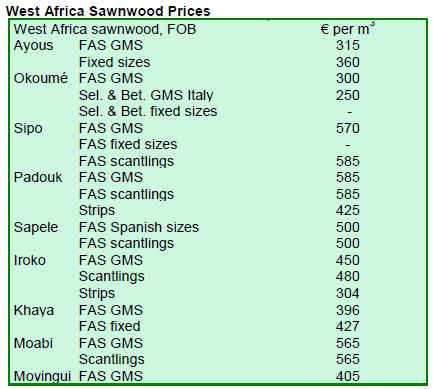
2. GHANA
Ghana¡¯s third quarter export permits take slight fall
According to data provided by the Timber Industry
Development Division (TIDD) of the Forestry
Commission (FC), 2,196 export permits were vetted,
processed, approved and issued to exporters during the
third quarter of 2008 to cover shipment of various timber
and wood products through the ports of Takoradi and
Tema as well as for overland exports to neighboring
countries.
Compared to the number of export permits issued in the
second quarter of 2008, which totaled 2,319, third quarter
results fell 5.30%. This decrease could be attributed to the
slump in trade due to the summer holidays in the European
Union and North America, which are Ghana¡¯s two main
markets.
Lumber kiln-dried (KD) and air-dried (AD) consisted of
45.49% of contracts, registering the highest number of
export permit applications for the period under review,
resulting from higher demand for these products than for
tertiary wood products such as furniture parts, moldings,
floorings, dowels, broomsticks and profile boards.
Substantial decreases in the number of permits were issued
in the third quarter for the export of blockboard, layons,
floorings, dowels, moldings, boules, sliced veneer and
rotary veneer. Nonetheless, there were significant
increases in the number of permits issued during the same
period for the export of teak billets/poles/logs. This
increase may be attributed to heightened demand for this
product by India and Hong Kong.
Three hundred and thirty eight export permits, with a total
volume of 32,937m3 and valued at EUR10.30 million,
were issued to a number of timber companies for overland
export of lumber, plywood and/or blockboard by road to
Burkina Faso, Nigeria, Niger, Mali, Benin and Togo.
Celtis rotary veneer in the US market commanded an
average price of USD500/m3, which was USD9/m³ more
than the GSP of USD491/m3 in the quarter under review.
During the third quarter of 2008, two rubberwood
contracts were given to Best Glow Wood Limited to
supply 2000 m3 each of rubberwood lumber to Tan Eng
Hout & Sons and Hsin Foogn Manufacturers Limited,
Chinese buyers of wood products from Malaysia. These
were the largest contracts signed by the company since
July 2007 and secured an improved price for rubberwood
of USD160/m³, up from the previous level of USD130/m3.
Smaller volumes of sliced veneer contracts were approved
for John Bitar & Company Limited and Logs & Lumber
Limited to supply this product to buyers in China, India,
Russia and Singapore, which previously had not been a
preferred destination for the product. It is anticipated that
these markets would be further expanded to receive larger
volumes in the future.

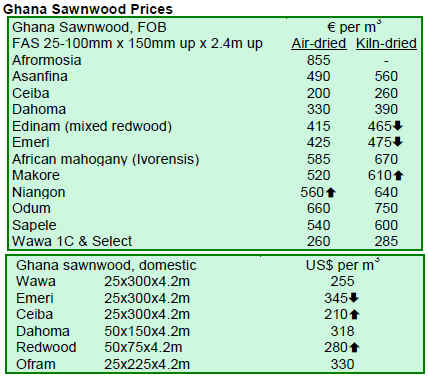
3.
MALAYSIA
Malaysian timber prices suffer sharp declines
Prices of Malaysian wood products have declined sharply
as the global economic slowdown began to deeply impact
the industry. The price decline was the steepest since the
Asian financial crisis in the late 1990s.
Timber merchants and wood products manufacturers alike
were rushing to reduce inventory by offering bulk
discounts to buyers. Some timber merchants lamented that
many of them had not received any new orders from
buyers beyond January 2009.
Both manufacturers and sawmillers were facing the grim
prospect of scaling down businesses in the near future.
Between 30% to 50% of small and medium-sized
businesses may be forced to shut down by end March
2009. There was a fear that up to 70% of workers in the
timber industry may be laid off before end 2009.
Limited demand for Malaysian timber debilitate furniture
industry
The recession in the US, reflected in the latest job data
revealing a total job loss of 2.6 million in 2008, has
brought the Malaysian furniture industry nearly to a
standstill. Manufacturers are now counting on existing
demand from the Middle East to keep their factories in
operation for the next six months.
Any expectation of fresh orders from European buyers for
sawn timber has mostly evaporated. Many European
buyers have opted to have their deposit forfeited than to
take delivery of any stock of sawn timber.
A number of sawmills are expected to close down
permanently after the Chinese New Year at the end of
January 2009. An increasing number of warehouses in
Malaysia are also experiencing slow moving stockpiles of
plywood and other panel products, reported The Star.
Malaysia and EU to sign VPA in early 2009
Bernama reported that Malaysia and the EU were
expected to sign a Voluntary Partnership Agreement
(VPA) within the first three to four months of 2009. The
announcement by Vincent Piket, the EC ambassador to
Malaysia, indicated that the EU was continuing
negotiations on the EU¡¯s acceptance of Malaysia¡¯s
certification system for timber. He noted that acceptance
of the new system would mean that Malaysian timber
would not require further certification in the EU market.
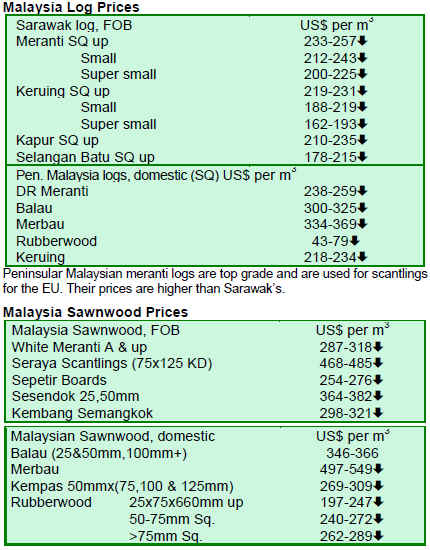
4.
INDONESIA
Prices decline despite slide of rupiah
News that China is gradually increasing its export tax
rebates for plywood sent jitters throughout the Indonesian
plywood industry, which is already struggling to cope with
the global economic downturn. Prices of Indonesian wood
products continue to decline sharply even as the Indonesia
rupiah depreciates against major traded currencies.
Nevertheless, the lower exchange rate has not been able to
encourage more buyers of Indonesia¡¯s plywood.
According to The Jakarta Globe, the Indonesian
government is stepping up its effort to assist the industry
by creating a USD4.64 billion economic stimulus plan.
Indonesia is counting on infrastructure projects that will
help stimulate consumption within the local population.
However, layoffs within the Indonesian wood products
industry are already taking place as several timber
concessionaires and forest plantation owners begin
curbing logging operations. With many development
projects coming to a standstill in major cities across
Indonesia, demand for logs is low due to a glut in sawn
timber supply.
Pulp and paper industry to use wood from natural forests
Antara reported on the Indonesian forestry ministry¡¯s
reversal of an earlier decision to ban paper and pulp
companies from harvesting wood from natural forests. The
reversal was taken as the ministry was facing problems
with a deficit in log supply from forest plantation projects
for the pulp and paper industry, caused by some
companies delaying the start of plantation projects and
premature harvesting of plantations, causing greater
uncertainty in wood supply. As a result, the ministry was
forced to reconsider its policy of preventing pulp and
paper companies from using wood from natural forests.
The pulp and paper industry will now be able to use wood
from natural forests, if supply from timber estates is not
available.
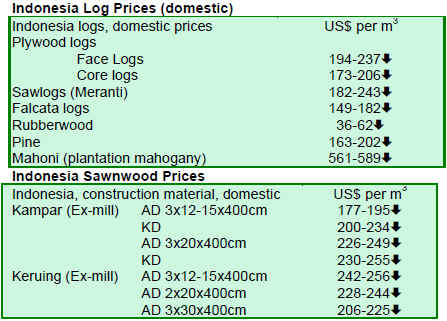
5.
MYANMAR
Average tender prices for teak hold stable in December
2008
Teak prices for December 2008 were generally stable
except for some of the higher grades, with MTE selling
about 800 tons in the tender. This limited quantity helped
tender average prices stay at previous levels. Buying and
selling were slow, given the current low level of demand
in the market. With poor economic outlook in developed
countries, Myanmar producers did not expect a dramatic
turnaround in the trade situation in the near future. Some
exporters were also reported to be planning for higher
sales to the domestic market.

6. BRAZIL
Para to soon launch sustainable forest concession
O Liberal reported that the state of Par:¢ will soon accept
the first bid for a sustainably managed forest concession.
The Para Forestry Institute (IDEFLOR) has indicated that
the concession area will be about 150,000 hectares within
a total area of 1.3 million hectares and will have a forest
use plan prepared by the state, which will be released in
February 2009. Studies on land use restrictions are
currently being concluded in the concession area. These
restrictions will assist land use planning to identify
traditional community areas, biodiversity preservation and
conservation areas and areas to be used for economic
purposes.
Of the over 15 million hectares of state forests, IDEFLOR
states that when management plans for state conservation
areas of the Calha Norte region are completed in 2010,
there will be a supply of over 8 million hectares of legal
concessions in Par:¢. The new plans are anticipated to
revamp the forest economy for the state and solve land
conflicts.
According to IDEFLOR, 2008 was a key year for many
reforestation activities such as the establishment of seed
labs of native forest species in the Tailândia, Altamira and
Marab:¢ municipalities. These initiatives will stimulate
seedling production and expand reforestation programmes.
In addition, other actions will be taken to revitalize forest
nurseries, establish West Par:¢ University and the Santarem
Technological Complex focusing on forest products
technologies.
Northern Mato Grosso municipalities lead in timber
sales
The municipality of Sinop has led in timber sales in the
state of Mato Grosso for the last three years, representing
15.5% of the state¡¯s total trade, according to the State
Secretary of Environment (SEMA). These statistics,
reported in S:® Noticias, take into account the participation
of each municipality in the volume of sales for exports, at
the domestic level and sales within the municipality itself.
Within the state, Aripuanã is the second leading
municipality, with 9% of sales, followed by Juina (7.6%),
Colniza (6.7%), Juara (4.8%) and Alta Floresta (4.7%).
The remaining 135 municipalities make up 51.6% of the
remainder of sales.
SEMA also published a report on wood species
commercialized under the GF3 Forestry Control Bill (Guia
Florestal GF3). The report indicates the volume of
commercialized species in cubic meters, the value and
average price, including sawnwood, laminated veneer,
sliced veneer, wood chips, block and logs of native tree
species, among others. The top commercialized species is
Cedrinho (12.4%), with Ip:º ranking second (9.8%) and
followed by Jatoba (8.4%), Ita:²ba (5.9%), Garapeira
(5.2%), Cambara (4.7%), Amescla (3.8%), Angelim Pedra
(3.5%) and Cumaru (3.1%).
Paras forest sector continues to experience declines
O Liberal reported that in 2008, a large number of
companies and employees of the Brazilian forest sector
were negatively affected, with exports decreasing about
35% from the state. The state of Par:¢ reported a 19.4% fall
in exported volume compared with results for 2007.
According to the Association of Timber Industries
Exporters of Par:¢ State (AIMEX), the state of the timber
industry in 2009 will depend on how the new US
government supports its key economic sectors. According
to the latest survey released by the Department of
Statistics and Socio-economic Studies (DIEESE), seven
thousand jobs were lost in the forestry sector in Brazil in
2008. The main factors were the North American financial
crisis, which began with the real estate sector, eventually
impacting the entire financial sector and causing sharp
falls on stock exchanges and reduction in access to credit.
The crisis has also impacted major consumers of forest
products, including the civil construction sector.
It is hoped that after the US financial situation stabilizes,
Para¡¯s business opportunities will improve. However, the
forestry business will also have to overcome the slow
process of approving forest management in natural forests
by environmental agencies. The Industry Federation of the
State of Par:¢ (FIEPA) noted that the global financial crisis
has caused the suspension of sale contracts with
companies located in Para, and those who have continued
selling have had to revise product prices. Importers are
also revising their approaches to adapt to the fluctuating
market, with many creating new strategies in response to
the current market situation.
Exchange rate has little impact on Brazilian timber
companies
Gazeta do Povo reported that after almost two years of
low profits triggered by the rise of the Brazilian real
against the US dollar, recent reverses in the trend have
done little to assist profits in the timber sector. Producers
working in the international market have not made much
profit in Brazilian real since demand and prices for
Brazilian products have been falling. On the other hand,
producers depending on the domestic market may also
face the same problem and without attractive prices for
products, the timber sector may continue on a path of
stagnation.
In the state of Parana, until 2006, the US market accounted
for 60% of Brazilian exports, which reached about USD1
billion per year. When US housing construction began to
fall, timber shipments also dwindled. In response to this,
the first action taken was to diversify export destinations.
European countries, particularly England, Germany and
Spain had been increasing their exports imports over the
past few years, but are now asking for price reductions
given the current state of the economy. According to the
Brazilian Association of the Mechanically Processed
Timber Industry (ABIMCI), the fluctuation of the
Brazilian real against a number of currencies has badly
affected the timber industry. Exporters are facing
difficulties obtaining bank credits and prices for contracts
have been very low. The interest rate has jumped from 6-
8% per year to 14-18% per year due to the exchange rate
alone. Timber companies have also become more
dependent on the domestic market. Domestic plywood
consumption, fueled by civil construction, increased by
15% in 2008.

7.
PERU
Peru to plant 2 million trees to combat climate change
Peru¡¯s National Soil and Water Conservation Program
(Pronamachcs) is undertaking an initiative to plant 40
million trees in Peru to combat the effects of climate
change, including through the capture of carbon dioxide.
In Junin, it is expected that over 2 million trees of different
species will be planted. The districts of Chupuro and San
Juan de Iscos will also begin planting trees, with the view
to planting over 32,000 seedlings as part of the national
initiative.
Germany provides EUR20 million to preserve Peru¡¯s
forests
Peru¡¯s Environmental Minister, Antonio Brack Egg,
announced Germany¡¯s contribution of EUR20 million to
Peru, which will be utilized over the next year and a half
to conserve primary forests. Brack was able to negotiate
the deal, along with other agreements on technical
capacity building and CO2 certification, during his recent
visit to Germany. In addition, Brack attended the recent
UN Framework Convention on Climate Change
Conference of the Parties in Poznan, where he stressed
that Peru could achieve emissions reductions over the next
10 years at a cost of USD5 million per year. Brack noted
that Peru would need international assistance to achieve
the ambitious goal, but that half of the required finances
had recently been provided by Germany. To obtain further
assistance, he indicated that Peru was undertaking
negotiations with The Netherlands, the UK and Finland.
INRENA Chief calls for more certified wood products
The Chief of the National Institute of Natural Resources
(INRENA), Mr. Jos:¦ Luis Camino, recently called on the
government to increase the amount of Peru¡¯s certified
wood products. He noted that certification would help
educate the industry and strengthen forest management by
concessionaires. He stressed the importance of Peru¡¯s
forest products, saying that the total value of Peru¡¯s forest
products grew from USD13 million in 1990 to USD322
million in 2007.
Camino said Peru¡¯s forests had been reduced to 18.7
million hectares for a variety of reasons, including
deforestation, drug cultivation and trade and a growing
population around forest areas. He also cautioned that a
high percentage of wood products were used for fuel. In
2007 alone, more than 87% of wood products were used
for the production of fuel. Over 7 million types of wood
products extracted from the Peruvian Amazon have been
turned into mostly wood and coal.
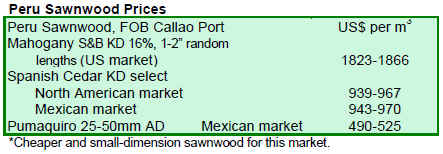
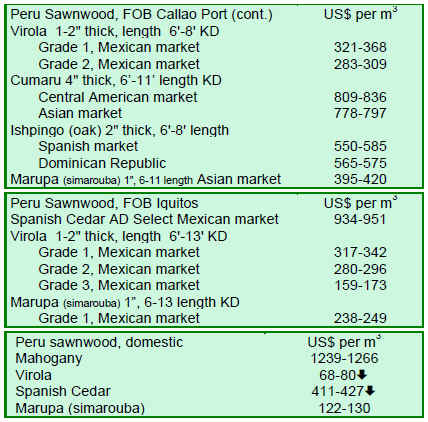 8. PERU 8. PERU
8. BOLIVIA
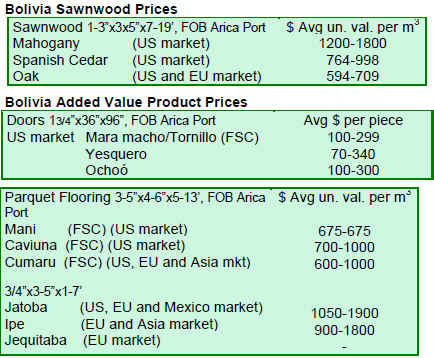
9.
Guyana
Guyana¡¯s 2008 market trends show mixed results
In 2008, domestic prices for Guyana¡¯s forest products
were mixed compared with 2007 levels. The greatest price
increase was recorded for splitwood, rising 61% over 2007
prices, and was closely followed by similar hikes in
plywood, which moved on average from USD366 in 2007
to USD538 in 2008. Prices for fuelwood rose 29% on
average. Price declines were greatest for roundwood.
The average price level for exported products showed a
more positive trend per cubic meter for logs, lumber and
plywood. Though there were small improvements
recorded for some products, others such as logs and
undressed lumber showed significant improvements in
prices. Robust gains in prices for roundwood per m³ were
recorded during the same period.
Log prices increased approximately 25% over the twelve
month period, moving from USD123/ m³ in January 2008
to USD154/ m³ in December 2008. Other trends over the
twelve month period included: undressed lumber prices,
increasing 26%, from USD422 to USD531; dressed
lumber and plywood prices, each rising approximately 9%,
from USD581 to USD631 and USD384 to USD419,
respectively; and roundwood, jumping 70% from USD206
to USD352.
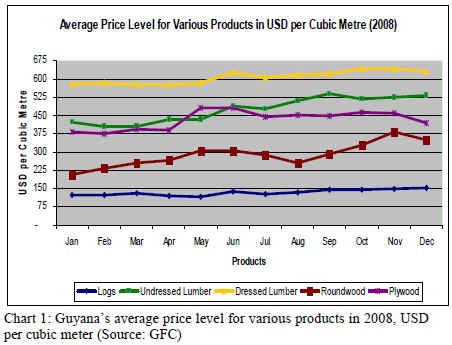
Log export volumes in 2008 were 41% less than the
accumulated total for 2007, the largest fall for any forest
product. Sawnwood export volumes also declined by more
than 8.2% over 2007 figures, although this was less
significant than the decrease in log exports because of the
larger volume of dressed lumber exported. Plywood
volumes were 35% lower than 2007 levels.
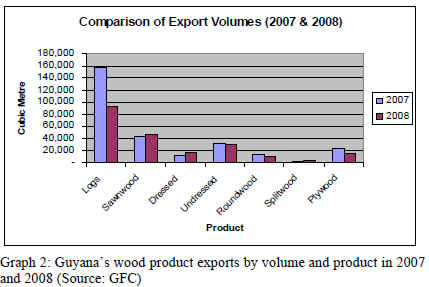
The total export value earned for Guyana¡¯s forest products
was supported by higher average prices per cubic meter
throughout the year. Values for plywood and logs fell by
26% and 25%, respectively. Other products that recorded
gains in the same period were dressed lumber (62%) and
sawnwood (19%).

By region, the Asia/Pacific region was the most important
export market for Guyana¡¯s wood products by value,
although revenue from this region in 2008 was 11% lower
than in 2007. The Latin American/Caribbean region
continued to import a significant share of Guyana¡¯s
products, with the value of exports to this region
increasing 3% over 2007 levels. The value of exports to
the North American market fell by 5%, while revenue
from the European market was up 27%. However, the
smaller contributors to Guyana¡¯s export revenues
increased their market share in 2008. Countries in South
America and Africa contributed a larger amount to
revenues in 2008 than in 2007, with revenue from these
regions increasing 26% and 83%, respectively.
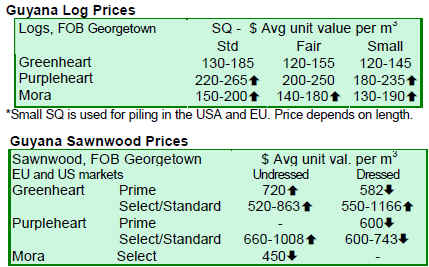
Guyana
|